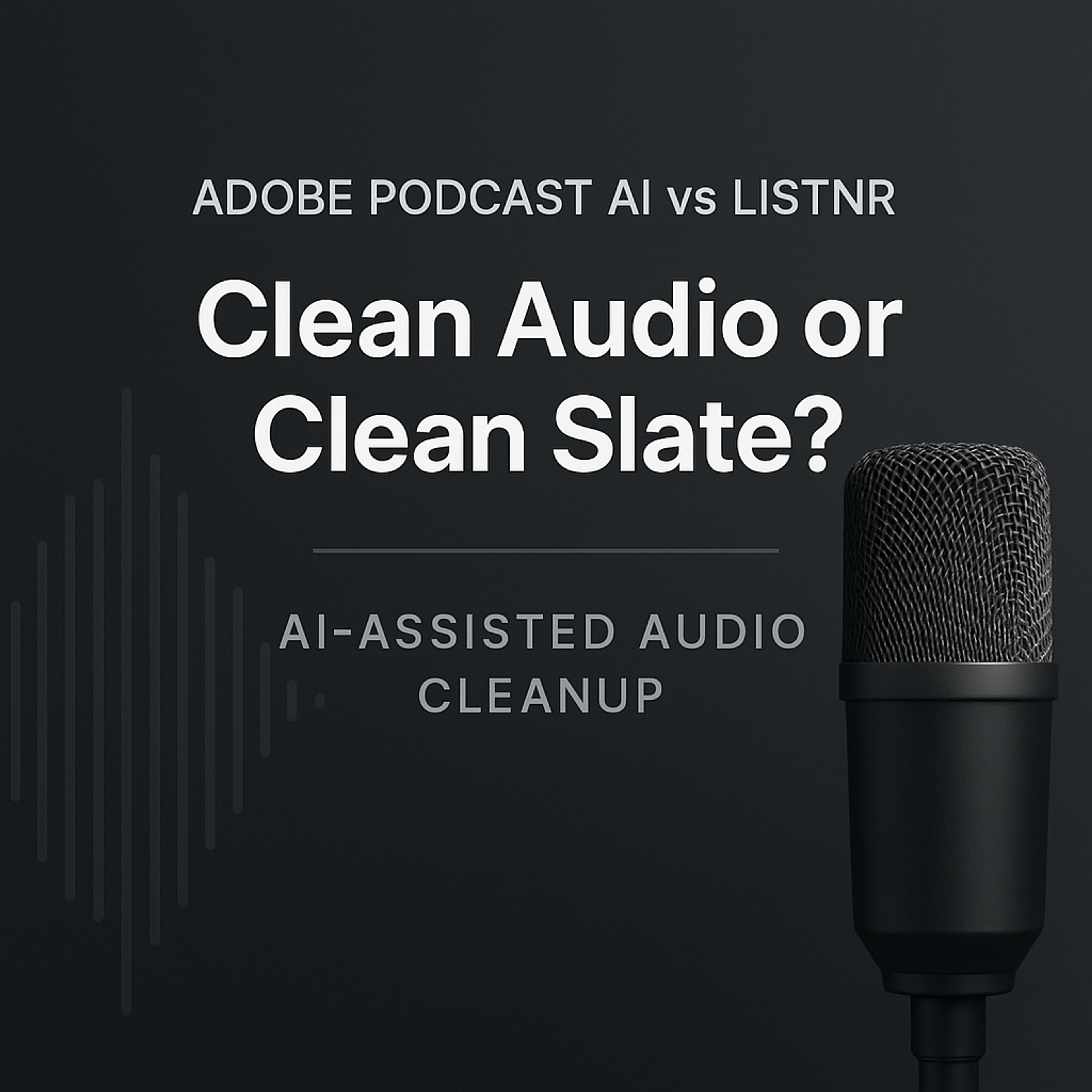Everyone has seen the before/after clips.
Garbage Zoom audio in, studio-sounding voice out.
Adobe Podcast’s Enhance Speech filter is the poster child of “AI-assisted audio clean up” in 2026. One click, less noise, less echo, less room tone. For creators, podcasters, and course builders, it looks like magic.
But here is the real question if you are running a serious content engine:
- Is Enhance Speech actually enough for your workflow
- Where does it slot in vs proper AI voiceover tools
- When do you use Adobe’s cleanup vs generating clean audio with something like Listnr from the start
TL;DR
Use Adobe Podcast Enhance Speech when:
- You already recorded human audio (Zoom, Riverside, in-person) and it sounds rough.
- You need a one-click clean up for voice tracks, interviews, or simple podcast episodes.
- You are fine staying in the Adobe ecosystem.
Use Listnr when:
- You do not want to fight bad recordings at all.
- You want clean, controllable, multilingual voiceovers for podcasts, videos, training, support, or faceless content.
- You care about speed, consistency, and scalable production more than rescuing broken audio.
Most serious teams end up using cleanup tools as band-aids, and Listnr (or similar) as infrastructure.
What Adobe Podcast Enhance Speech Actually Does
Adobe Podcast is a browser-based suite with three core pieces relevant here:
- Enhance Speech
AI filter that removes background noise and echo and boosts clarity so it sounds closer to a treated studio recording. - Mic Check
Quick AI analysis to tell you if your mic position, room, or levels are off before you hit record. - Studio & utilities
Web recording, simple multitrack edits, transcription, captioning, audiograms, and integration with the broader Adobe ecosystem.
Enhance Speech is the hero: upload a file, let the model work, download cleaner speech.
Great idea. Good execution. But not magic.
Key Features (No Hype)
1. One-click cleanup
- Upload noisy voice recordings.
- AI removes room noise, hum, fan sounds, light echo.
- Output often sounds dramatically clearer, especially on laptop or webcam mics.
Perfect when:
- You recorded a guest on hotel WiFi.
- You have a webinar, panel, or interview that would be painful to re-do.
Limitations:
- Can make voices sound slightly hollow or over-processed if pushed too hard.
- Struggles when original audio is extremely distorted or clipping.
2. Video and bulk support (Premium)
On paid plans you get: Adobe Podcast
- Video file support (MP4, MOV, etc).
- Bulk upload and batch enhancement.
- Adjustable strength so you can dial back the “radio booth” effect.
- Higher daily processing limits.
This matters if you are cleaning a full YouTube library or a course series.
3. Studio, captions, and workflows
Adobe Podcast also gives you:
- Cloud recording with separate tracks.
- Simple timeline edits.
- Transcription and captions.
- Audiograms and light branding utilities.
If you already live in Adobe land, this feels familiar and integrated. If you do not, it is “nice to have” but not a full DAW replacement.
Pricing Snapshot (2026)
Adobe Podcast currently runs on a simple free + premium model:
- Free
- Enhance Speech with limits (shorter files, no bulk, audio only).
- Limited Studio exports.
- Basic Mic Check.
- Premium (around $9.99/month or yearly discount)
- Longer files and higher daily caps.
- Bulk enhancement.
- Video support.
- More flexible Studio usage and customization.
Verdict: Pricing is reasonable if you already depend on it. For one-off fixes, the free tier is enough.
Where Adobe Podcast Enhance Speech Shines
Use it when:
- You are a podcaster or YouTuber fixing human recordings, not generating new voiceovers.
- Guests send you terrible audio and you do not want to reschedule.
- You run an interview-style course or coaching program where authenticity > perfect TTS.
- You do not want to learn a full DAW just to clean up background noise.
Enhance Speech is a great “salvage and sweeten” tool. It turns unusable into publishable.
Where It Falls Short For Heavy Operators
If you are running a content machine, Adobe Podcast alone will not cover you.
- It is still patching bad source audio
You are dependent on mics, rooms, and guests. If they are bad, you are always in rescue mode. - Limited as a full narration engine
No deep catalog of AI voices purpose-built for long-form, multilingual narration. It is an enhancer, not a replacement for a voice talent stack. - Fine, not obsessive control
You cannot micro-tune tone, pacing, pronunciation, or emotion like you can with modern AI voice platforms. Great for “fix this,” less great for “scale this to 400 lessons in 3 languages.” - Throughput and process
Large academies, agencies, and media teams need structured projects, roles, and high-volume generation, not just upload-click-download loops.
If your workflow is mostly human-first and occasional, Adobe’s tool is perfect. If your workflow is system-first and high-volume, you need something built for that.
Adobe Podcast vs Listnr: Different Jobs, Use Both Correctly
Think of it like this:
- Adobe Podcast Enhance Speech
- Fixes what you already recorded.
- Ideal for podcasts, interviews, panels, webinars, organic-style content.
- Best when you still want your real voice or guest voices, just cleaned.
- Listnr
- Generates clean audio from scratch.
- Ideal for courses, faceless YouTube, explainers, training content, UGC ads, documentation reads, product education.
- Voices are consistent, controllable, multilingual, and instantly re-generatable.
When Listnr is the obvious pick
Use Listnr as your primary stack when:
- You want to skip recording and editing entirely.
- You are building Thinkific or Teachable courses, product academies, onboarding flows.
- You run agencies that need dozens of on-brand voiceovers each week.
- You care about clear licensing, scalable pricing, and reliable quality.
You can:
- Write scripts once.
- Choose one or more voices that match your brand.
- Generate or update modules in minutes, not schedule studio time.
When to combine both
A lot of teams run this simple pattern:
- Use Listnr for all planned, evergreen, scripted content.
- Use Adobe Podcast Enhance Speech only to clean the occasional live recording, guest segment, or legacy audio that is worth saving.
No hero worship, no overkill. Each tool does its job.
Quick Decision Framework
Ask yourself:
- Am I trying to fix messy recordings or avoid them entirely?
- Is this a one-off podcast episode or a library of structured lessons?
- Do I need multiple languages and consistent voices across 6+ hours of content?
- Will my team use this weekly as part of a pipeline, or once a month as a rescue button?
If you are fixing, Adobe Podcast Enhance Speech is great.
If you are building systems, use Listnr as your foundation.
FAQs
Is Adobe Podcast Enhance Speech good enough for pro podcasts?
For many setups, yes. It significantly improves noisy recordings. But if your source is really bad, or your bar is broadcast-level, you should still care about microphones, rooms, and basic technique.
Should I clean audio with Adobe or switch fully to AI voices?
If your content is personality-driven (hosts, founders, interviews), clean it. If your content is instructional, repeatable, or faceless, generating with Listnr is usually faster and more scalable.
Does Adobe Podcast replace a full DAW?
No. It is a smart layer on top of basic editing. For deep mixes, music, complex sound design, you still want tools like Audition, Reaper, Pro Tools, etc.
Can I use Adobe Podcast output commercially?
Adobe provides clear licensing terms for its tools. As always, read the current terms and make sure your usage fits. For AI-generated narration where you plan to build real revenue and brand assets, pick providers that are explicit about commercial rights.

About Ananay Batra
Founder and CEO @ Listnr Inc
Ananay is the Founder & CEO of Listnr AI, he started Listnr with $100 in the bank back in 2020 and scaled it to 3mn+ users across 200 countries and $1.2m in revenue.
https://ananay.ai/